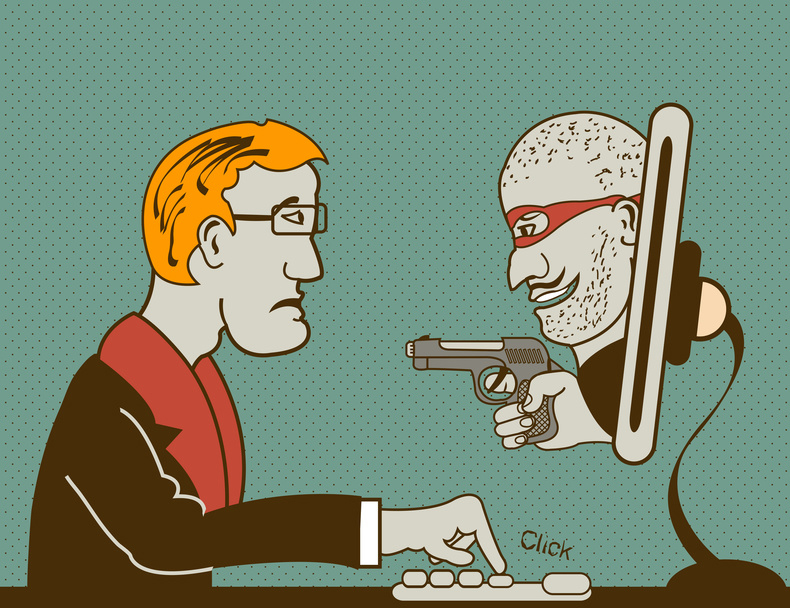
Posted by
Mordy Oberstein
This past December the largest ad fraud scam to **** was unearthed. Methbot, operated by a group of Russian hackers, was estimated to have sucked anywhere up to $5 million a day from the pockets of online advertisers. However, unlike Russian hacks related to the 2016 elections in the US, the problem of click fraud has not been plastered across various forms of news media from sea to shining sea. The question is why? Is click fraud, statistically speaking, not as significant as the sensational plundering that was executed by Methbot? What precisely is the monetary significance of click fraud? How long has it been a problem? What is being done about it? Are we doing enough? Can we do enough? Simply, how old, big, and daunting is the problem of click fraud?

The Financial Impact of Click Fraud – A Brief History
The obvious thing to do first
is follow the money trail. How much money are we talking about here? Are bots that are clicking online ads siphoning off pennies, or are we talking big money, and if so how big? Ultimately, if we want to get a sense of how the advertising industry has fared in dealing with click fraud, it behooves us to wrap our minds around the enormity of the problem (or the lack thereof, but come on, if this wasn’t a big problem, would I really be writing a whole post on the issue?).
Let’s then attempt to do this methodically, by looking back at how much money click fraud has cost the good people advertising online on an annual basis. Perhaps we can even see some trends emerge (again, you know you’re going to see some trends emerge right?).
Click Fraud Costs to the Industry in the Year 2013

So, one of the unique things about click fraud is that it’s not as new of a problem as you may think, though it’s taken on new life more recently. Online advertising being the behemoth that it is, is still in
it’s youth. Click
fraud however, has been plaguing the industry since the very infancy of the “modern era” in digital marketing. In 2006 Google settled a class-action suit claiming that it did not do enough to prevent click fraud for $90 million and in 2005 Yahoo settled such a suit as well, that’s over 10 years ago already. Despite perception, click fraud has been around for some time at this point.
Yes, click fraud is not a new issue, but lawsuits and all, I’m going to jump to 2013 where I estimate the issue of click fraud started to become more popularized as the numbers just started to get away from everyone. In fact, it was in 2013 that famed ad contrarian, Bob Hoffman addressed the issue in his blog… The Ad Contrarian. Based on a 2013 Wall Street Journal article that said a whopping 54% of display ads never appear before a human, Bob estimated that click fraud was costing advertisers $7.5 billion a year! (Bob also suggested that to a large extent and for a variety of reasons, click fraud was a taboo topic that no one wanted to deal with, a claim that forms the crux of this issue and one we’ll get into a bit later.)
2014 – A More Comprehensive Look at the Costs of Click Fraud
While Bob Hoffman didn’t get his $7.5 billion figure from a data crunched study of sorts, he was not far off at all. In 2014 we started to get some hard numbers coming at us. Notably, Solve Media, who presents a CAPTCHA service, estimated that the advertising industry would see $11.6 billion wasted into the depths of click fraud.
Also in 2014, White Ops (the same digital security firm that uncovered Methbot) and the Association of National Advertisers (ANA) released data on what was one of the first serious and comprehensive pieces of research on click fraud. The study examined 5.5 billion impressions across 36 advertisers… major advertisers (AIG, Johnson & Johnson, Kimberly-Clark, and 33 others of the same caliber). The result was a predicted $6.3 billion to be lost to bots perpetrating click fraud in 2015.
An Uptick in Ad Fraud Focus – 2015
While 2014 saw some initial figures and the first real study on the click fraud problem, 2015 marked a change in how the industry actually approached and acted towards ad fraud. Suddenly, there is this sense that click fraud can’t be dismissed as something of the past as some had proposed. With the White Ops/ANA study, click fraud came into serious focus, at least more so than before. In fact, 2015 saw the first IAB (Interactive Advertising Bureau) report and analysis on click fraud (that’s a whole 10 years after Yahoo lost its click fraud lawsuit, hard to believe right?). To this, the IAB concluded that in 2015 $4.2 billion dollars were thrown down the drain thanks to click fraud.

The IAB report also provided some insight into the breakdown of click fraud per device, revealing that 72% of the practice was on
desktop while 28% occurred on mobile. And though the IAB’s figure was about $2 billion under the White Ops/ANA forecast, $4.2 billion dollars flushed down the toilet is no small thing. So whether you look at the predictive numbers from White Ops/ANA or the IAB study, click fraud and the bots perpetrating it, is costing advertisers multiple billions of dollars and now, the big **** in the industry were focused on it and releasing data on it. This in it of itself, marks a shift towards actually dealing with click fraud.
Click Fraud in 2016 and Beyond
Though 2016 just ended, we do again have some predictive data from White Ops and the ANA. Upping the number of companies participating to 49, the study analyzed 2015 click fraud figures to create a fraud trajectory for 2016. Just two years after the initial baseline study, White Ops and the ANA predicted that 2016 would produce $7.2 billion in click fraud waste and theft. While the actual 2016 numbers have yet to be released, that’s a hefty amount money that’s expected to be squandered.

Looking beyond 2016 and the click fraud picture looks bleak, really bleak. If you can take away one trend from the data I’ve presented here it’s that the problem is not going away. You would expect that a parasite sucking off billions of dollars would be attacked and diminished. Instead, as indicated above, the problem
remains, and is only getting bigger. Whether you look at the IAB’s numbers or those from the White Ops/ANA studies, the industry does not have the advantage on the problem.
Indeed, a 2016 World Federation of Advertisers (WFA) report presents a dark future for advertisers. According to the report, by 2025 there’s a good chance that ad fraud could eat up a whopping $50 billion, a figure the report considers to be conservative! If you think that’s bad, the report indicates that some third party research has shown that 88% of all digital ad clicks (currently, not in 2025) are phony and that bots make up over 60% of traffic out there on the web, with a year-over-year increase of 22% in 2016. If I were Tom Hanks in the critically acclaimed movie, Apollo 13, I might say something like, “Houston…. we have a problem.”
The Digital Marketing Industry Responds to the Ad Fraud Problem
As click fraud has become the growing and large beast that it is, the advertising industry has begun to shape a stronger and more formal response. That is, at this point in the game the industry has sort of woken up and is starting to fight back in various ways. This is at least a start, as we’ll see.

The Advertising Industry Speaks out Against Click Fraud
Simple as it may sound, but one of the main changes in the fight against click fraud is how vocal certain industry leaders have become on the topic. Truth be told, this is a significant development. Without a certain sense of both outrage and
urgency the issue of click fraud stands to face a destiny of languid irrelevancy. When people like the CEO of the Association of National Advertisers say things like, “The industry needs to deal with the problem effectively and the fraud needs to be put to its death“
that’s a big deal, simple of a statement as that is.
This sort of vocal onslaught has translated into substantive action and demand. In 2015 commercial giants such as AIG and MillerCoors took to the streets in protest and demanded that their publishers prove that their ads made it to the eyes of real people and not the claws of a click fraud bot. Such a sentiment has been echoed throughout the industry as transparency is becoming paramount in its importance.
Perhaps summarizing the state of the industry and its renewed push to collectively deal with click fraud, was the WFA report that predicted click fraud reaching $50 billion by 2015. The report, in its executive summary, notes
that, “Behavior change is required across the industry, which can only be achieved with appropriate understanding, motivations, and a common shared approach.”
The Trustworthy Accountability Group and the Formal Fight Against Click Fraud
Analogous to the increase in industry outspokenness, in late 2014 the Trustworthy Accountability Group (TAG) was formed out of the
embers of what was the Trustworthy Digital Supply Chain Initiative. Besides for being less of a mouthful than its previous incarnation, TAG has helped shape the “modern” war on click fraud in profound ways. It’s most famous achievement (other than assembling a board of directors that consists of the upper echelons of the industry) has been its Certified Against Fraud Program.

The Certified Against Fraud program is fundamentally a verification status that can be applied to any of the parties within the digital advertising ecosystem (i.e. publishers, fraud detection vendors, intermediaries such as Google etc.). TAG awards its status and
seal to those parties who comply with their Certified Against Fraud Guidelines released in May 2016. Being awarded the seal from TAG is essentially a way for everyone to know that you’re not going to plunder and pillage them with some sort of fraud scheme, or even facilitate such a scheme.
Last December TAG awarded the seal to its first “class” of applicants, giving the status to 16 companies. Obviously, having 16 companies with the seal is a drop in the sea of advertising entities. However, TAG and its Certified Against Fraud status is significant in that it represents a move towards a sweeping set of standards, is emblematic of formal industry-wide push-back against click fraud, and offers the industry a universally recognizable symbol of trustworthiness. All in all, TAG is symbolic of a big step forward when it comes to dealing with ad fraud.
The Government’s Response to Ad Fraud
At the end of the day we’re talking about theft here, and large-scale left at that. You would think that there would be some sort of law against click fraud, i.e. stealing. After all, the government protecting the rights of property is the one thing people from across the political spectrum can agree on. Ironically, none exists (in the US), at least on the federal level (it is ******* in California… yippy). Industry advocates say, that with a federal law, associating parties (i.e. not those releasing the bots per se, but those turning a blind eye to such bots) will be hard-pressed to keep such associations, as the activity being perpetrated would be *******.

While it is inexcusable that there is no federal law barring an activity that results in the theft of billions of dollars, the traction that the issue now has within the advertising industry has had a modest effect on policymakers. This past July, my home state’s senator and current Senate Minority Leader, Chuck Schumer along with Virginia’s Mark Warner, petitioned the Federal Trade Commission to take up and tackle the issue of click fraud. The appeal came on the heels of the aforementioned WFA report that indicated a $50 billion click fraud threshold by 2025.
Having two top senators push the FTC is nice, and it shows that the industry has some clout. Though I’d have to say that you would expect the industry to have just a wee bit more of a political sway than just two politicians, especially considering that their petition seems to have had little to no impact.
Is the Advertising Industry Doing Enough to Prevent Click Fraud

Washington’s malaise and indifference aside, is the industry itself doing enough? I ask the question out of the context that this is an issue that goes back to the early 2000’s that has not only
worsened, but has worsened exponentially reaching ominous proportions. I ask the question because despite this being a multi-billion dollar problem, many of us are not aware of it to the extent we should be. If we were I wouldn’t need to write this article. Despite the issue being discussed within the industry’s media, I would personally expect a lot more coverage of an issue that has cost us so much money. So I’ll ask it again, are we doing enough?
Obviously what I’m asking is the equivalent of a leading question within the legal world,
however the numbers bear it out. While 55% of advertisers employ an ad fraud detection mechanism, just 40% of advertisers even have an anti-fraud policy. This is perhaps indicative of the fact, that while the industry has increased its focus on click fraud, that awareness is not as pervasive as it should be, and
subsequently industry action falls a bit short. This is perhaps why industry leaders, like Unilever CMO Keith Weed, have directly addressed the industry, specifically advertisers, to up their game and increase their vigilance in only associating with certified publishers, etc.
Such notions are
inline with the general understanding that a sort of culture shift has to change within the industry where individual advertisers take it upon themselves to ensure they only deal with legitimate vendors that provide transparency. As indicated, it doesn’t seem that we’re there yet.
This is a sentiment shared by Bill Duggan, the Group Executive Vice President of the ANA. In a February 2016 interview with AdWeek, Duggan was quoted as saying, “Clearly there are technical tools. But I believe that the most effective tool is a commitment by advertisers to personally combat ad fraud…. Advertisers, it’s your money and you should steward your investments.” This was a sentiment shared by White Ops CEO Michael Tiffany, and VP of Media for Heineken USA, Ron Amram who both made similar statements in the same AdWeek interview.
An Actionable Step to Combat Click Fraud Going Forward
With the shortcomings enumerated above, some industry experts have made recommendations going forward, which I feel are pertinent to discuss briefly. One of the main themes “the experts” discuss is greater transparency. In real
terms this means that contracts between advertisers and publishers should include penalties for distributing ad content to parties that practice unscrupulous advertising practices. Doing
so, is just one of the ways advertisers can grab the bull by the horns and effectuate a change.
My Take on the Click Fraud Problem

To validate my wife’s view that I’m too opinionated, I’ll offer my unadulterated opinion of the “click fraud problem.” I’m going to apologize in advance if I come across too critical, because to be honest, something stinks here. Having sat down, really “hitting the books” on the issue, I was left scratching my head. At one point during my research process, I closed all the dozens of open tabs I had open, and with a bit of righteous anger jotted the following three questions down in my notes:
1) Why is there such a lack of response to this issue? Where are the big players? Why isn’t Google blacklisting sites and entities? Why does the response to ad fraud fall on the good graces of organizations like TAG?
2) Are we even equipped to respond the way things stand?
3) Do any of the guidelines and initiatives, whether it be TAG or the IAB make any difference at the end of the day? Do they have a real and lasting impact or are these initiatives symbolic at best, a placebo at worst?
The answer to these questions
are certainly up for debate, but the need to ask them is in a sense overwhelming. The trends and forecasts all point to click fraud being a long-lasting, ever-growing problem, as evidenced by Methbot. And it’s wonderful that the industry is starting to rally behind a solution, but we’re talking about billions of dollars lost in theft here, it’s an outrage.

The very notion that the campaign to end click fraud occupies the wrinkles and crevices of industry media is in it of itself out of sorts. Think about it like this, we as an industry spend far more time discussing slight changes to Google SERP features, or tests to
AdWords, than we do the theft of billions upon billions of advertising dollars. Excuse me for saying this, but something does not sound right.
Let me qualify my righteous outrage with a few observations about click fraud, specifically the response to click fraud, that I’ve noted along the way while conducting my investigation.
1) The industry seems to be mostly on the defensive, with a lack of a coordinated and potent offensive.
2) The industry, due to a lack of a coordinated offensive, is chasing its own tail.
3) Too much commentary and advocacy
comes from brand executives, not that this is a bad thing, but there is not enough from advertising and industry institutions.
4) The fact that click fraud is not a federal ***** is absurd, and the industry needs to advocate with a collective voice for that level of accountability.
There is something unhealthy about how the problem of click fraud is being processed and subsequently dealt with. I’m not a psychoanalyst, so I have no deep insights as to why this is happening, all I can say is that it is happening. The lack of response from all the players within the industry, the staggering volume of the theft, the inability to effectively advocate for serious legislation, in totum paints a sickly sort of picture that is uncharacteristic of an otherwise powerful industry.
How to Move Forward and Face the Future of Click Fraud
If there is one underlying theme to the problem of click fraud, it’s that there is a pervading lack of unity. If the industry wants to deal with this problem, and tackle it head-on, it needs to form a unified response that for all intents and purposes would be an ingathering of all of the relevant parties from across the advertising industry. The inability to effectively deal with click fraud up until
now, has not been due to a lack of policy or technology, at least not essentially. The foremost element on which an effective response to click fraud rests is industry unity and the power that the concept harbors.

I understand that we of all people naturally trend towards a technical response, but the fundamental issue is that of industry unity. Until the industry, from search
engines, to advertisers, to policy makers, come together to seriously deal with click fraud, the problem will remain. Stephan Loerke, the chief executive of the WFA said it best when he said, “Advertisers are the sole victim of ad fraud…. There is much that advertisers can do to improve the situation in terms of setting new standards, contractual changes, and increased transparency, but ultimately behavior change is required across the industry.” …. Well said, I have nothing more to add.


![YMYL Websites: SEO & EEAT Tips [Lumar Podcast] YMYL Websites: SEO & EEAT Tips [Lumar Podcast]](https://www.lumar.io/wp-content/uploads/2024/11/thumb-Lumar-HFD-Podcast-Episode-6-YMYL-Websites-SEO-EEAT-blue-1024x503.png)

